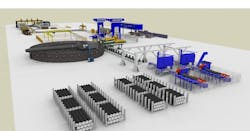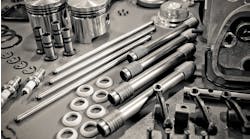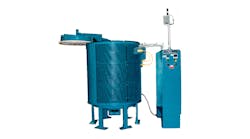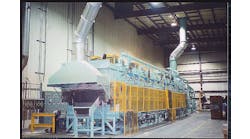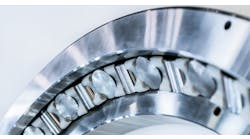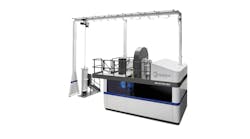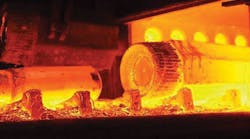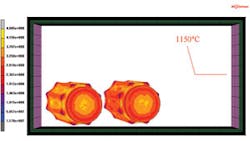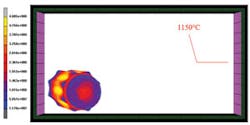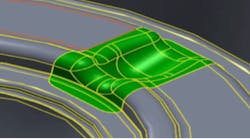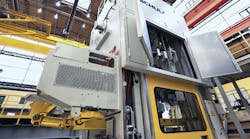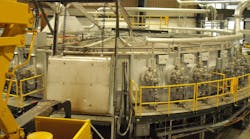Latest from Heating
Pilsen Steel is a Czech manufacturer of steel ingots, ductile- and gray-iron castings, and finished machined forgings for a multiple industrial markets, including power generation and shipbuilding. Two-thirds of the company’s shipments are exported, and have been used in high-profile projects all over the world. For example, Pilsen Steel provided the wheel shaft and 200 metric tons of other castings for the London Eye Ferris wheel. Pilsen Steel also is one of the world’s highest-volume producers of wind turbine shafts, and one of the largest suppliers of large crankshafts for four-stroke diesel engines.
Pilsen does all of its production at one plant, in the city of Pilsen, in the western part of the Czech Republic, where it has steelmaking, metalcasting, forging, round and finish machining operations. Recently the company recognized a problem with material cracking on a batch of 34CrNiMo6 steel ingots during forging.
After casting, the ingots had been quenched in water to 500°-600°C, prior to reheating in a soaking furnace to temperatures of 1,100°-1,200°C. It was unclear whether the cause of the cracks had been the heating or the forging operation, and Pilsen contracted Comtes FHT a.s. to investigate, determine the root cause, and suggest a remedy.
Comtes FHT is a non-profit organization focused on applied research for industrial partners involved in the production of metal products. Its services include fracture-toughness testing, high-temperature testing, fatigue testing, strain measurement, material analysis with electron microscopes, electron backscatter diffraction (EBSD) analysis, and energy dispersive X-ray analysis (EDX) of chemical composition. The organization is experienced at physical testing, material analysis, computer simulation, process design and development, and prototype manufacturing.
Pilsen Steel supplied the ingot and furnace geometries to Comtes FHT as 2D drawings. Comtes researchers reproduced the ingot geometry in desktop CAD software, then created a simple 2D axisymmetric model of a single ingot and the furnace wall. Comtes obtained the material properties for the simulations through experimental tests that included thermal capacity, thermal conductivity, heat expansion coefficient, and phase transformation.
Recreating Parameters
Using MSC Software’s Marc nonlinear finite element analysis (FEA) software, Comtes researchers simulated the process of heating the ingots in the furnace, which by then had been suspected as the root cause of the cracks.
The researchers ran a thermal and stress analysis for a period of five minutes from the time the ingot was placed in the furnace. The simulation showed that the cracks originated in areas where high thermal stresses were generated as the ingots were heated in the furnace. The results showed very high stresses in the ingot, so the simple 2D axisymmetric model was expanded to a full 2D model also consisting of a single ingot.
“Performing thermal analysis on the complete ingot workload required determining the radiant heat transfer between the furnace and each of the ingots, with shading effects taken into account,” said Dr. Filip Tikal, computer-modeling specialist at Comtes. “It’s a highly complex and challenging multiphysics problem. A very effective finite element analysis software was an essential part of the process.”
Next, the researchers expanded the 2D model by adding additional ingots to determine the effects of the placement of the ingots in the furnace, and of the shading of ingots from radiation heat transfer by other ingots. The actual layout and materials of the ingots in the workload were monitored in the plant for several months to ensure accurate modeling of the ingot placement.
Next, a complete 3D model consisting of the furnace and a typical load of ingots was analyzed. This 3D model provided verification of the 2D analysis, and supplied a more detailed prediction of the location of the cracks, which was used for validation by comparing the analysis results with inspection data. These results confirmed that the process of heating the ingots in the furnace-generated thermal stresses that later caused cracks to form during forging.
Researchers were able to predict which ingots would develop cracks and the location of those cracks. In both the analysis and in production, cracks were primarily seen on ingots placed near the wall of the furnace.
Evaluating potential solutions
After Comtes FHT discovered the source of the cracking, Pilsen Steel asked for an evaluation of potential resolutions to the problem. It was clear that the problem was caused by thermal gradients during the heating operation. The furnace temperature could not be reduced, so the researchers wondered whether raising the ingot temperature would eliminate the cracking problem and, if so, what would be the lowest ingot temperature that would eliminate cracks?
Comtes researchers ran a series of analyses while varying the starting temperature of the ingots in 50° increments. A / (HPC) cluster with 32 cores was used to provide a fast turnaround on this more complex analysis. The results showed that raising the ingot temperature to 700°C completely eliminated the cracking problem. The researchers worked with Pilsen Steel engineers to modify the soaking process used to cool the ingots after casting to ensure that ingots would be at least that temperature when they were placed in the furnace.
As predicted by the Marc analysis, when these changes were implemented the cracking problem was eliminated. Now, Comtes FHT is starting a project of further improvement to Pilsen Steel’s forging process, by optimizing the heat transfer within the furnace.
Srinivas Reddy is a senior product manager for MSC Software, which develops programs for multidiscipline analysis and simulation in numerous industrial, defense, electronics, and other process applications. Contact him at [email protected], or visit www.mscsoftware.com


